#as male snow ptarmigans are
Explore tagged Tumblr posts
Text
Rest assured, he is harmless. He's just a small, petty little thing.
Just... Don't barge into my dorm room without my permission. Or his. He is a bit territorial.
I have a bit of a dilemma.
I seem to have recently acquired a companion of sorts on a recent mission to a particularly winter-y area, and... Well...

I have named him Columba, after a constellation just south of Canis Major and Lepus. I have already fitted them with their own device to stabilize their atomic resonance and avoid any upsets.
Debating whether or not I will devise a translator of sorts for Columba, unsure how much chaos that would create. We will see...
#as male snow ptarmigans are#h.a.s.s.#humanoid android surveyor system#nano spider#spidersona#oc rp#.LOG
29 notes
·
View notes
Text
Animal of the Day!
Rock Ptarmigan (Lagopus muta)
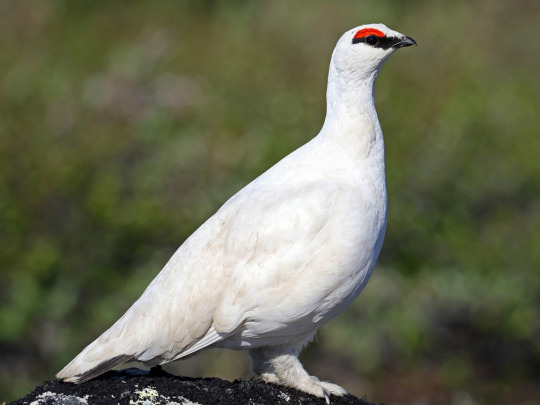
(Photo by Cameron Eckert)
Conservation Status- Least Concern
Habitat- Greenland; Iceland; Northern North North America; Northern Asia
Size (Weight/Length)- 600 g; 35 cm; 60 cm wingspan
Diet- Leaves; Flowers; Berries; Seeds; Plant buds
Cool Facts- The rock ptarmigan is one of the only birds to have the ability to change color. These grouse are brown in summer and slowly switch to white over a period of several weeks once snow begins to fall. Instead of migrating south when temperatures drop, rock ptarmigan shelter down and brave the storm. Unable to store large amounts of fat like other overwintering birds, rock ptarmigan are forced to constantly eat to stay warm. Males sport bright red eye combs that are used to gain mates. The brighter the color, the healthier the rock ptarmigan, and the more likely he is to pass on his genes.
Rating- 11/10 (I still have no idea how to pronounce their name.)
#animal of the day#animals#birds#grouse#wednesday#december 27#rock ptarmigan#ptarmigan#biology#science#conservation#the more you know
297 notes
·
View notes
Text
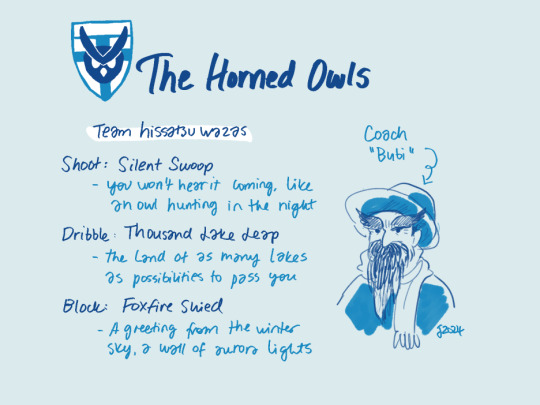
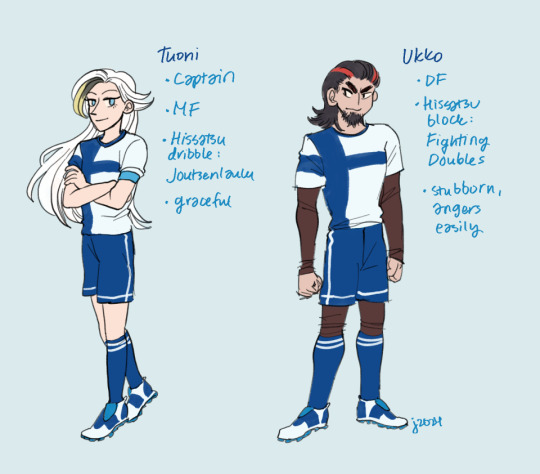
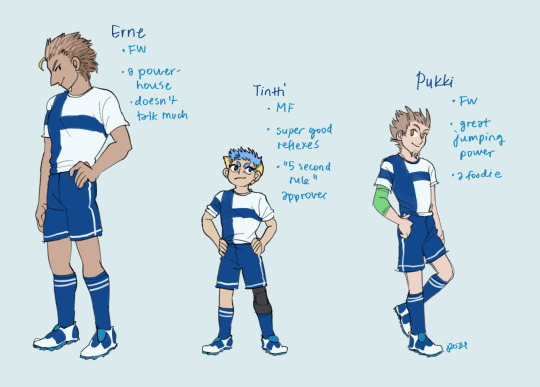
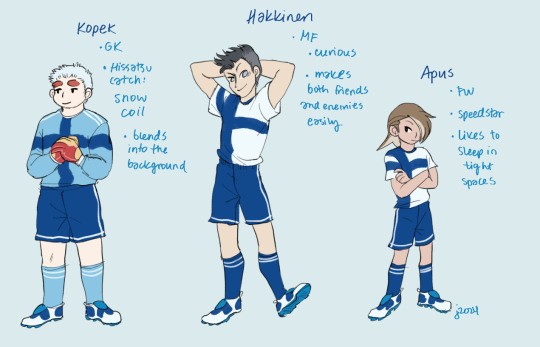
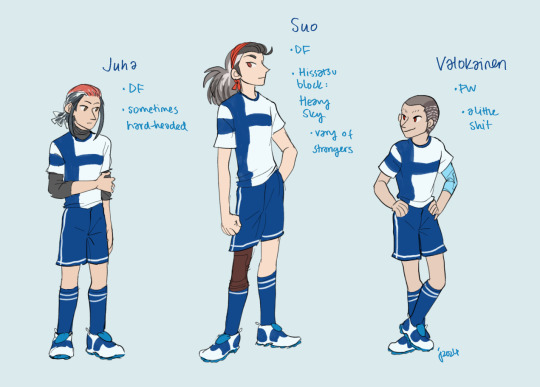
here it is - a fan design for the finnish national team in i11 universe!
I tried to add as many references to birds and finland as I could, and I'll put them under a cut if someone's interested!
general team notes:
our actual national soccer team is named Huuhkajat (the horned owls) after a horned owl that one day randomly started to live in the team's home stadium building - hence the team name and bird theme
that owl got named Bubi, and this team's coach is based on him
general team hissatsu are themed after owls or famous finnish things
all the players are based on the official(?) regional birds
Tuoni:
based on a whooper swan (laulujoutsen), which is the national bird (captain status)
hissatsu is named after a famous finnish song (literal translation: a swan song)
name comes from the swan of Tuoni; a swan that swims in the river to afterlife in Kalevala, and anyone who harms it will die
Ukko
based on a wood grouse (metso)
hissatsu is a reference to a famous painting "Taistelevat metsot" which decipts two grouses battling
name means an older man or a guy, and the male bird is also called "ukkometso"
Erne
based on a white-tailed eagle (merikotka)
name is from the first finnish-built space craft part, and the symbol of the project was a white-tailed eagle
Tintti
based on a blue tit (sinitiainen)
"tintti" is a general nickname for tits (the birds), but also the finnish name for Tintin
Pukki
based on Teemu Pukki, probs the most famous finnish soccer player
and his last name literally means a goat (vuohipukki)
that's all
Kopek
based on a willow ptarmigan (riekko)
most grouses in northern finland make a coil/a nest in the snow for warmth and safety from predators, and his hissatsu is directly borrowed from that
name is literally the sound the bird makes (kopek-kopek-kopek..)
Hakkinen
based on a western jackdaw (naakka)
name is an historical name for the bird, and Häkkinen is a common family name here
Apus
based on a common swift (tervapääsky)
name comes from the latin name (apus apus)
Juha
based on a white-backed woodpecker (valkoselkätikka)
name is.... based on a teacher I had, who was called both Juha and literally a woodpecker.... (this is an inside thing for just me sorry)
Suo
based on a common crane
hissatsu comes from an old belief of cranes carrying the weight of the sky, and they're the most notable species that fly in wedges
name means literally a swamp, which has been the best place to spot cranes here
Valokainen
based on a black-throated loon (kuikka)
name is from an old finnish poem singer, Elessei Valokainen. A loon is in an important role in the earth-diver myth that tells the creation of the world, and Valokainen's story of it from 1908 has been recorded
I also forgot to wrote it in the image but want to mention, these birds have the most iconic cry on summer lakeside evenings, so Valokainen has a laugh that kinda sounds like that
#inazuma eleven#whooo boy this was a fun bunch!!#I also learned a lot myself about birds and culture lol#suo is my fav bc the crane is my fav bird and I'm biased#own art#original character#inazuma fan team
44 notes
·
View notes
Text
a male rock ptarmigan in winter plumage sits in the snow. Courtesy of Mark Lindberg.

1 note
·
View note
Text

Saw a pair at my grandma's feeder last Sunday and the male was like, halfway-yellow, so yeah.
There are other birds that do this though (most famous being the willow ptarmigan), usually for the purposes of camouflage against snow vs camouflage against grass/leaves/what have you. This guy does it for a similar reason (camouflage in the winter vs "I'm hot and single" in the summer)
the goldfinches a5re turning yellow again fuck yessss
12K notes
·
View notes
Photo

Rock Ptarmigan (Lagopus muta)
Family: Pheasant Family (Phasianidae)
IUCN Conservation Status: Least Concern
Common in Arctic and Subarctic regions of Europe and North America as well as in cold, mountainous regions of Asia and central Europe, the Rock Ptarmigan is a terrestrial bird that inhabits snowy tundras and mountainsides where it lives alone or in small flocks and feeds on leaves, seeds, buds, fruits and small invertebrates. In order to avoid predation (chiefly by larger birds such as Golden Eagles) they rely heavily on camouflage, and to facilitate this their plumage changes dramatically with the season: during the spring their feathers are largely brown or grey to allow them to blend in with rocks and grass, but as winter approaches they develop a thicker coat of white feathers that makes them difficult to distinguish from the snow around them. Males of this species (such as the individual pictured above) can be distinguished from females thanks to the fleshy red “combs” above their eyes which can be extended upwards to ward off rivals intruding on their territories. During the spring mating season, the eye combs may also be used as part of a dramatic courtship display in which several males gather together and simultaneously compete for the attention of nearby females by extending their combs, stretching out their tail feathers, flapping their wings, bobbing their heads and producing a deep, croaky call.
---------------------------------------------------------------------------
Animal Advent Calendar - Day 6
Image Source: https://www.inaturalist.org/taxa/949-Lagopus-muta
#december 6th#rock ptarmigan#ptarmigan#phasianidae#bird#birds#zoology#biology#ornithology#animal#animals#north american wildlife#asian wildlife#european wildlife
265 notes
·
View notes
Photo

Male rock ptarmigan (Lagopus muta) on spring snow
Lungau, Salzburg, Austria
#original photography#wildlife photography#photographers on tumblr#nature photography#Ornithology#snow#winter#birds#Salzburg#Austria#Austrian Alps
38 notes
·
View notes
Text
"A Panther Is Found
She was captured at dawn in a deep, dusty pitfall in India. After months of spitting and growling during her journey by cart, train, and ship, the frightened black panther finally arrived -- on a cool October afternoon -- at the Zürich Zoo. She was dropped into a cage with a nasty-tempered male as black and sleek as herself. His scent disturbed her her; his advances were unwelcome. They slashed away at each other until they were exhausted, then stared from opposite corners of their shared cell. The next morning, she was found bloodied, and was moved to a solitary, indoor cage. Straightaway, she notices a small vent opening in the roof of her enclosure, from which she smelled the outdoors. She waited until dark to claw and squeeze her way out of the vent into the moonlight, panting under a frosty night sky. She vanished like mist into the windy, snow-burdened Alps.
On the morning after her escape, a zookeeper found fur and blood on the vent of her empty cage. The zookeeper dreamed of the cat many times that autumn and winter. He dreamed of her shifting into supernatural forms. She was an inky specter floating above the powder, leaving no spoor, striding through the air. Her face came growling at him out of a whiteout, in a kind of burning, charcoal fury. He dreamed she killed Ibex, Ptarmigan, hare, and chamois on the steep, craggy heights. For the next ten weeks, no trace of her was found. Even after a hungry farm laborer discovered her under a barn and killed her for food, the zookeeper's dreams continued. On Christmas he dreamed that she haunted the site of her death, her lingering spirit climbing a branch of smoke from the firepit she had been roasted over. He could see the blood of her butchering spread across the snow. This tropical feline refugee, surviving in the cold of the Swiss winter, continually troubled his sleep. Eventually the dreams faded away and were forgotten.
About a decade later, in 1950, Heini Hediger published a zookeeper's manual and used the escape of the black panther as a case study in a chapter on cage-breakers. Twenty years ago I have taken what I could from Hediger's dry account and imagined the rest. This is the way I work. Most of what is written above is imagined. A series of paintings might begin with the discovery of an almost forgotten book. A firsthand account, however brief, will fuel the fantastic. If all goes well, a panther magically escapes and melts into the landscape. She is out there somewhere; I stay in my studio and try to find her.
-- Walton Ford, 2020"
Walton Ford, Panchayat Tantra, Taschen
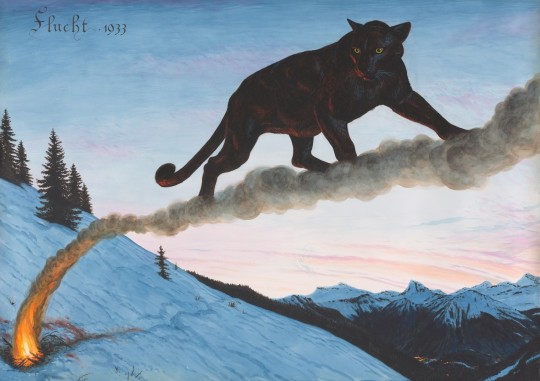
Walton Ford - Flucht
299 notes
·
View notes
Photo









Harpy races in the Schism, the world @etheralavarice and I have built~
More info under the cut:
Corvians are the harpies of the night, and are among the most advanced of the harpy races, living in large, dense civilizations with intricate, gothic-styled architecture. Crow-type corvians are the “commoner” race, the majority of the population. Ravens are considered of royal blood, and are usually found to be high ranking individuals among communities. As smart and clever as they are, they are not below playing tricks on other people, and are known to be very mischievous. However, due to current conflicts, the Corvians have since dwindled in numbers, many of their cities have been reduced to ruin, and the few remaining survivors are on the run, hoping to rebuild and retake what was lost.
Grallistrixes (or Grallixes), equal to the Corvians in intelligence and innovation, differ by being more reserved and live more nature-oriented lives. They value wisdom and knowledge, and loathe conflicts. As a result, Grallixes are the most pacifistic of the species, and are very welcoming to strangers, even non-harpies. However, it is this pacifism that lead to their demise, as Grallixes are now almost completely extinct, with only a few, hidden individuals left behind, who have long since abandoned that calm and peaceful lifestyle and have learned to take arms… and they seem to have taken a fancy for archery.
Gyrfalcons (or Gyrs), despite their more bestial appearance, are on par with the Corvians and Grallixes in terms of societal advancements. They tend to live closer to either shorelines or by cliffsides, and live by a stern, disciplined lifestyle. They are rather boastful and think highly of themselves, which result in clashes with the other races, most notably the Corvians, who love to get their ire for the sheer fun of it. They are also a bit dense, and tend to not detect sarcasm easily, thinking would-be “compliments” to be true, only feeding their ego.
Sagittas, unlike the other races, do not form groups or civilizations with themselves, but instead have chosen to blend in and mingle with the human race. As a result, they are the most human-like of the harpies, both physically (having reduced scaling on their arms, shorter claws, and the ability to disguise their feet with footwear that resemble high-heeled shoes), and behavior, having abandoned unique traditions and culture in favor of more human-standard ones. Some Sagittas have taken the liberty to form safe havens for harpy refugees that are on the run or in hiding, hoping to help them rebuild their destroyed civilizations in the future.
Trogons are among the most primitive of the races, forming tribes that live in forests, having few innovations with their technology, and possess their own strange yet fascinating cultures and beliefs. They also have the greatest examples of sexual dimorphism, with the males being a lot more colorful and feathered than the female. Male trogons are the warriors, hunters, and gatherers of the tribe, while the females are the farmers, caretakers, and builders. Due to a massive war they’ve lost to the Condors (losing much of their people and territory in the process), Trogons have become rather xenophobic and highly territorial, not trusting any sort of foreign race into their land… at least not so easily.
Condors are the most loathed of the harpy races. They are a militaristic group, with the most advanced examples of tools and technology, having created their own versions of guns, some even reverse engineered that they have stolen from human settlements. They live under strict conditions, highly disciplined, raised under the thought that they are nothing more than tools for the greater good. Condors have been said to have struck a deal with demons and the like, and as a result, have wiped out many civilizations, including their fellow harpies. They possess little to no morals, having ease doing actions that most other races would deem cruel or heartless. However, some individuals have broken from tradition, and have formed groups of defectors and rebels that seek to go against their kin’s bloodstained paths.
Casuars, living on an isolated island that was (and still is) seething with untamed arcane power, have become corrupted people. They wield arcanery with great skill and even greater malice, and are more than eager to use this power to inflict pain upon any living thing, even their own. While the Condors are deemed evil and merciless, the Casuars trump them with the addition of having very little sanity remaining. They do have enough sense in them to at least form strange groups that resemble cults, performing rituals and sacrifices together in hopes to appease their god, and speak in a language that consist of shrieks and clicks. Be wary when fighting a Casuar, however… for if the crest on their head is broken, it will start to uncontrollably release the stored arcane energy within, destroying the Casuar’s brain, and eventually detonating, obliterating both the Casuar and everything within its immediate vicinity.
Ptarmigans and Fiddlesqueaks, appear quite out of place, and look more like huge birds than harpies. Do not be fooled, they are still considered such. Both species are considered, for the lack of a better word, quite derpy and klutzy. They have formed very simple groups that live together, and seem to have just the bare minimum level of sentience and intelligence. Both do not speak, instead only utter noises that resemble “orp” and “eep” respectively. What’s even stranger is… you can understand them regardless.
Ptarmigans live in blizzard-wracked tundras, and live in one area, and one area alone. They do not wander, they do not form shelter, sometimes even being buried in snow, with wanderers seeing globular mounds of snow only to reveal it is a birb, still living, and seemingly does not mind its situation. It is a complete mystery how they are still live and kicking, but after some observations, it is now known that they actually possess supreme magic powers that allow them to be practically omnipotent. However, their intelligence dampens this ability, and they only use it to basically conjure things that pop up in their head. If a ptarmigan is hungry, it simply thinks of food, and food will appear before it. If a ptarmigan wants to be warm, it WILL be warm, even in the thickest of blizzards. Ptarmigans also wear random headgear. It is not known how they got it, or why they wear it… but it’s theorized they’ve seen travelers with hats, loved it, and mimicked them ever since. They do not know what hats mean, they just wear it for sheer amusement. If you see one with a pope hat, that is not a pope. Leave it alone.
Fiddlesqueaks resemble ptarmigans, but they reside in forests instead of tundras, and are just a smidge more clever, enough to survive without the need of blind omnipotence. They know how to forage and hunt, even form basic shelters in the branches of trees, but still very simple-minded. They are hard-working, though, and while they do not comprehend complex orders, they do simple ones very efficiently, to the point that you may find Fiddlesqueaks in random places to act as slaves or workers.
#harpy#rayart#bird people#bird anthro#bird person#corvid#corvian#crow#raven#gyrfalcon#falcon#grallistrix#stilt owl#owl#secretary bird#trogon#quetzal#condor#vulture#cassowary#ptarmigan#woodcock
14 notes
·
View notes
Text
my favorite ptarmigans are the ones that live in the snow and look like spherical fat fucks

you may not like it but this is peak male performance
40 notes
·
View notes
Note
Hello! Hope you're well! If you have a moment, could you do a daemon form analysis thing? I'm INFP-T, 5w6. Strongly introverted but good at playing extrovert, selective about friends, usually calm/easy going/lazy but friends say I can be very headstrong/aggressive when I need to be. People tend to like me even when I don't like them. Private but very approachable. I can fit in with anyone, if I want to, but I'd rather be alone at home. Hope that's enough info! Have a good day! Thank you!
ooo yes let me see here! it sounds like you’re someone pretty even-tempered and tolerant, but not the type to let someone tread on your boundaries. if you have no preference about your type of daemon i have a few suggestions!
various armadillo species seem like they’d fit you really well! the screaming hairy armadillo (independent but socially tolerant, plans ahead, goal-driven and determined, sensitive and habitual, unobtrusive, cautious, willing to be defensive, communicative) i thought might fit you the best; they’re typically very passive and easy-going, and their social tolerance and lack of high boundary-keeping makes them very approachable like you say. however they are willing to be defensive and would mostly just like to be left to their own devices. as far as some traits that you didn’t mention, they tend to be pretty habitual and routine-oriented people, who are highly sensitive to their environment and don’t like change. the nine-banded armadillo (habitual people who like to have a plan, also capable of being adaptable and not too fussed by change, socially tolerant and even-tempered, passive, needs personal freedom) is more flexible.
in that same vein, the anteater has promise too. the giant anteater i think would fit you the best; they’re similarly independent workers and introverted people, but are extremely tolerant and not terribly stressed by socialization. can absolutely be defensive but don’t seek out conflict. they’re more-so just aware of their boundaries and aren’t the type to be cornered or manipulated into doing something they don’t want to do. straightforward people who aren’t very anxious. extremely easy-going but efficient people who like to find a specialization.
the tree pangolin is a possibility but may be too private/not willing to be extroverted. introverted and independent but tolerant, very private, specialized and likes staying in their niche, laid-back, patient, flexible, not terribly organized, dedicated, stubborn, and defensive when pressed. they're much more guarded than the other species and much more... wary and suspicious of other people’s intentions, i think is a good way to put it. they’ve got an anxious streak but are willing to show a degree of flexibility and adaptability particularly if they can plan for it.
i was also looking at some species of birds and galliformes may be an option!
the ptarmigan might be a little too assertive as the males are pretty territorial; it used to be the habit of the daemon community to split male and female forms (such as: females will be more tolerant, males will be more assertive, etc) but nowadays it seems more the culture to combine them. i wouldn’t necessarily rule it out because it seems like you can be headstrong/aggressive. look at the white-tailed ptarmigan maybe? very grounded individual, introverted but extremely tolerant of others and overall easy-going. pragmatic unless loved ones are involved, they look out for their friends and are diligent people who don’t bite off more than they can chew.
quails are significantly less assertive than the ptarmigan, but also more socially tolerant and cooperative as they form convoys during the breeding seasons. generally very detail-oriented, perfectionistic, and cautious. the california quail seems like a good place to look. they're habitual people with an eye for planning ahead, and are capable of being very adaptable and being able to find their home anywhere. very diligent and dedicated people. considering they get territorial during breeding season, i would consider them generally conflict-avoidant but headstrong when pressed.
and finally partridges seem like they could fit. they’re very socially tolerant but not socially bold; they definitely come off as pleasant and approachable, but more wallflowers. anxious and habitual, very attached to their comforts. can definitely be possessive of their home, people, and possessions, but overall easy-going. they’re open and honest, and communicative about what they expect from their friends. they have difficulty staying grounded, though they’re highly adaptable and aren’t phased by slights from others. they can be very driven, vigilant, and inquisitive people. check out the snow partridge or crested partridge maybe?
hope this helps!
11 notes
·
View notes
Text



ARCTIC WOLF
Origin:: Canadian Arctic
/ARCTIC WOLF CHARACTERISTICS
Arctic Wolves generally are smaller than Grey Wolves, measuring around 3 to 6 feet (0.9 to 1.8 metres) long including the tail. Male Arctic Wolves are larger than female Arctic Wolves. Their shoulder heights vary from 25 to 31 inches (63 to 79 centimetres). Arctic Wolves are bulkier than Grey Wolves, often weighing over 100 pounds (45 kilograms). Weights of up to 175 pounds (80 kilograms) have been observed in full-grown males.
Arctic Wolves usually have small ears, which help the wolf maintain body heat. The alpha male is always the largest and will continue growing after other wolves had stopped. Arctic wolves can be black, grey or white.
/ARCTIC WOLF HUNTING
Arctic wolves, like all wolves, hunt in packs. They mostly prey on Caribou and musk oxen, however, they will also kill a number of Arctic Hares, seals, ptarmigan and lemmings, as well as other smaller animals. Moose are also common prey, their long legs may render them slow and at times, stuck, in thick snow, leaving them vulnerable to attacks by wolf packs. As grazing plants are scarce, they roam large areas to find prey up to and beyond 2600 kilometres squared (1000 square miles) and they will follow migrating caribou during the winter.
/ARCTIC WOLF REPRODUCTION
Normally, only the alpha male and female Arctic wolves breed, however, in large packs others may mate as well. Due to the Arctics permafrost soil and the difficulty it poses for digging dens, Arctic Wolves often use rock outcroppings, caves or even shallow depressions as dens instead. The mother gives birth to 2 or 3 pups in late May to early June, about a month later than Grey Wolves. It is generally thought that the lower number of pups compared to the average of 4 to 5 among Grey Wolves is due to the lack of prey in the Arctic. Female Arctic wolves have a gestation period of about 63 days. The wolf pups stay with their mother for 2 years.

At birth, wolf pups tend to have darker fur and their eyes have blue irises that will change to a yellow-gold or orange colour when the pups are between 8 and 16 weeks old. Though extremely unusual, it is possible for an adult wolf to retain its blue-coloured irises.
Arctic Wolves have achieved life spans of over 18 years in captivity; however, in the wild, the average life span is only 7 – 10 years.
2 notes
·
View notes
Text
Ptarmigan
Ptarmigan In winter, both male and female ptarmigans are totally white in colour, except for a black tail, beak and eyes. During the summer months, the male has a brown head, neck and breast with a white body, while the female’s entire body is a mottled yellowish brown. Ptarmigans have feathered feet that help them to walk in the snow Ptarmigans have three seasonal plumages per year that keep…

View On WordPress
0 notes
Text
RUSHCLAN INFORMATION
Fjaðrárgljúfur // Iceland
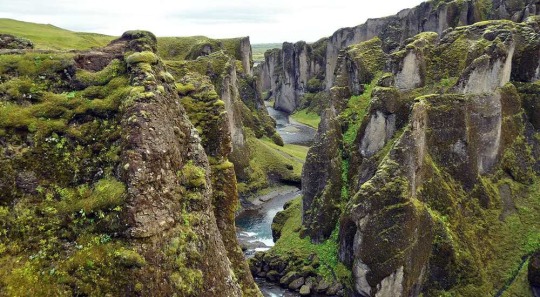
Camp // At the end of the ravine, a decently sized waterfall pours from above, leaving the rocks bare and salt sprayed. The water leads to a calm pool and river. Behind this waterfall is a small cave, which has been carved away by the water over several thousand years. The water has worn dens into the cave’s sides, leaving the stone incredibly smooth. The leader calls to the camp from a large volcanic column, which has a winding pathway up to the top carved into it. Territory // Rushclan’s territory is located in a ravine, which has been carved away by the rushing water for many thousands of years. Though primarily rock, the ground is also covered in rich soil, and plentiful in grasses and mosses. In many places, the walls are tall and steep, unsafe for even an adult warrior. Rushclan has specialised themselves in climbing the more manageable areas, however, and are experts in their ability. Cutting through the majority of the territory is a fairly swift river, the waters bubbling in the ears of cats from kithood to their graves. While some areas are safe to wade through, a slip in the wrong spot would mean certain death. Borders // At the other end of the ravine, which is an uphill climb, the river breaks into smaller streams, lacing themselves through dropclan’s territory. The outermost river, which curves around the outside of the ravine, is the border to dropclan. This still allows for the cats to walk above the ravine and survey their territory from above. Bayclan, however, is bordered by a thunderpath, which scorches any paws to touch it during high noon on a summer’s day. It is advised to cross, if you must cross, during night in the summer, and during the day in the winter. Prey and Predators // Rushclan is densely populated primarily with birds, and birds bring the infamous arctic fox. Common sightings include Atlantic Puffins (as the territory is very close to the sea, and the rocks are prime nesting location), Common Raven, Common Snipe, Arctic Tern, Rock Ptarmigan, and the elusive Golden Plover, which only shows its face when spring is nearing. The birds, as well as their eggs, are wonderful prey for the cats. However, the predators are just as plentiful. The arctic fox, as I mentioned before, is small and solidary, but will still pack a decent punch to a lone warrior. Snowy Owls, Gyrfalcons, and the intimidating white-tailed eagle. Rabbit, Vole, Mice, and Mink will occasionally be found near the clan borders. Pelt Colours // Cool greys and browns, with moderate white masking/spotting, is often the most common pelt colour in Rushclan. The cats have adapted to blending with both the cool stone and the winter snow. White cats, in any clan, are not uncommon. Rushclan favours short and medium coats (though double coat is still important due to the weather), and have adapted to have large paw pads to aid in climbing and traversing snowbeds. Names // Avian names are common, as well as anything playing off of water or the sea. Examples include, but are not limited to, puffin, wave, splash, duck, swan, and snipe. Morals // Rushclan is a proud clan. They are very loyal, and hold knowledge and adventure to a very high standard. They believe strongly in the balance of the three clans, as well as the warrior code. The newer generation is beginning to show a trend of trailblazers, however, who want to outlaw old fashioned thinking. Starclan is believed in heavily for their strength. males - 6 females - 4 nb - 2 (updated 11/25/18)
#rushclan#mobile info#mobile friendly#warrior cats#warriors rp#warrior cats rp#warrior cats roleplay#discord rp
2 notes
·
View notes
Photo

Ptarmigan by Pete Walkden A male, sat in deep snow. www.petewalkden.co.uk https://flic.kr/p/2iLjBqS
0 notes
Text
‘Seasonal Wonderlands’ review: Tracking the dramatic transformations in nature
New Post has been published on https://jordarnews.in/seasonal-wonderlands-review-tracking-the-dramatic-transformations-in-nature/
‘Seasonal Wonderlands’ review: Tracking the dramatic transformations in nature
Since we are stuck at home and travel looks light years away, we can visit exotic landscapes to watch stunning changes courtesy BBC’s nature documentary, Seasonal Wonderlands. The three-part series follows the forests of New England swapping green for gold and red, the mysterious Okavango Delta in the centre of the Kalahari Desert turn into a water-world and the beautiful and brutal land of ice and snow, Svalbard come alive when the sun warms the top of the world.
Narrated by Irish actor Domhnall Gleeson, the stately trees of New England’s forests fight an ongoing battle with crafty caterpillars, industrious beavers, vain moose who strip a tree bare to nourish their antlers, rattlesnakes, sapsuckers and mischievous chipmunks to don its autumn colours. The show follows the transformation from March for seven months for the “Midas touch of fall to the turn the forest into gold.”
Seasonal Wonderlands
Season: 1
Episodes: 3
Run time: 40-45 minutes
Creator: Paul Bradshaw
Narrator: Domhnall Gleeson
Storyline: Tracking three landscapes that change dramatically through the year
‘Okavango’ starts in the dry season in September, six months before the flood, where catfish are gasping for their last breath even as African fish eagles and jackals gather for a banquet. From that dust bowl, to see the transformation into a lush, green is nothing short of miraculous. The wet lands bring its own challenges from hippos fighting for supremacy to the baboons doing a strange jig in the water.
A still from ‘Seasonal Wonderlands’: Male hippopotamus fights can last for hours and are sometimes fatal | Photo Credit: Peter Bassett
Even as a wide variety of birds feed of pike and many other fish, one marvels at the Okavango River that does not go into the sea, instead forming the largest inland delta in the world.
Polar bears look so cute and cuddly that one forgets how dangerous they are. In Svalbard, as the sun warms up the Norwegian archipelago after four months of darkness, a rich wildlife is revealed that includes said cuddly polar bears, arctic foxes, sleepy walrus and reindeer.
Though these changes are so dramatic that they can be seen from space, one might as well live vicariously with the hyenas, warthogs, and plump ptarmigans.
Seasonal Wonderlands premieres on June 27 at 9 pm on Sony BBC Earth
Source link
0 notes